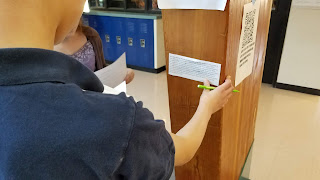This reading strategy engages students by having them moving around from station. Here is how it works.
My 8th-grade students were learning about slave life in the United States. The reading content is heavy, along with high-level vocabulary words such as antebellum and manumission. So, it's going to be challenging for my kids, but I knew they can do it!
During this scramble, my students work in teams. I encourage them to share information with each other. However, my expectations are very clear about this; sharing means verbalizing the information by explaining their answers. Not taking another worksheet and simply copying the information onto another worksheet.
To monitor progress, students gather information onto some kind of sheet to prove they have discovered the important information. For the scramble, students are working to complete a worksheet with fill-in the blank statements and short answer questions about the short readings at each of the stations.
But in a scramble the content is mixed-up. Because of this, students must read (and re-read) the information at each station to understand the information AND the context of the information. Then, they check their worksheet if the information is what they are seeking. But there is more...
There is duplicate information in the scramble stations. So as students move from station to station, they will discover the information is repeated. To make it more interesting, I change the font on the information sheets so it looks different. So students can't just glance at the station to see if it is the
HELPFUL HINTS:
- When creating the information sheets for each station, it is important to make them short, no long than two paragraphs. If a student (especially struggling readers) approached a station with more than eight sentences, there is NO WAY he/she will read it. Remember, this a kind of mad dash to find information, but students will be exposed to the information multiple times.
- Always finish the worksheet with one or two open-ended questions - I call these my "Thinking Cap Questions" These questions require students to synthesize information from the scramble. So, for this scramble, my Thinking Cap Question was, "On a scale of one to ten how you rate the treatment of American slaves. One is very bad and ten is super nice. Please explain your answer".
- Make it into a game. Sometimes I have teams compete with each other to be the first to correctly complete the worksheet. For this scramble, I did not do this.
CONCLUSION - To ensure all the students have the correct information, as a class I review the information. Also, I have students share their Thinking Cap Question answer with the class. Sometimes these discussions really get deep into the content and it engages students.




